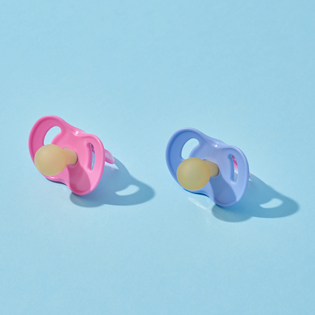Your toddler’s skin may be super soft most of the time, but it’s bound to get dry now and then.
For some tots, dry may be their complexion’s default setting — as with adults, some children are just naturally predisposed to dry skin or other skin conditions. Children with eczema or a family history of eczema, seasonal allergies, or asthma are also more likely to have skin that tends to get dry.
But there are plenty of other culprits that might contribute to your toddler’s dry skin, including being outside in cold weather and inside in dry heat, and sensitivity to chemicals and fragrances in some soaps and lotions, to name a few.
Fortunately, there are lots of simple strategies that can help restore moisture to your little one’s skin. Here's what to do to tackle your toddler’s dry skin.
Signs of dry skin in toddlers
Chances are, you know a case of dry skin when you see it. If your sweetie's skin is in need of some extra moisture, it might appear:[1]
- Dry or tight-looking
- Rough or patchy
- Ashy or flaky
- Red or irritated, especially if your toddler has been scratching it
Dry skin can strike anywhere on the body. In the winter, it might be especially noticeable in areas where your toddler's skin is exposed while playing outside, like her cheeks, hands or around her mouth (especially if she tends to lick her lips because they're chapped).[2]
What causes dry skin in toddlers?
Even though she's past babyhood, your toddler's skin is still baby-soft — and nearly as delicate. Young children's skin is thinner and more sensitive than adult skin, so it's more prone to becoming parched. Common moisture-zapping culprits include:[3]
Read This Next
- Using harsh soaps, which strip skin of its natural oils
- Cold, dry or windy weather
- Dry indoor air from central heating or space heaters
- Teething (which can cause drooling and subsequent rashes or dryness around the mouth)
Sometimes, dryness is caused by an underlying skin condition like eczema. Dry, red or scaly patches (especially in the crooks of the elbows, behind the knees, on the neck, or inside the wrists or ankles, with frequent scratching) are telltale signs of eczema, which can also make your sweetie's skin itchy and irritated.[4]
While run-of-the-mill dryness can typically be managed at home, keeping eczema under control can also warrant the help of your tot's pediatrician.
How can you treat dry skin in toddlers?
You can combat dryness by adding more moisture to your munchkin's skin — and helping it hang onto the extra hydration. That's usually easy to do with some simple at-home measures, including:[5]
- Get soap-smart. It’s hard to resist the temptation of sweet-smelling soaps or the promise of a cleaner clean, but a cleanser that’s free of soaps and fragrances is best to retain moisture in your toddler’s dry skin. (Antibacterial soaps are irritating too, so steer clear at bathtime.) You don’t need gobs to get the job done — a little goes a long way. And remember not to scrub, but wash your tot’s skin gently.
- Dry gently. Pat your sweetie's skin dry with a soft, cotton towel rather than rubbing it vigorously. A light touch avoids roughing up the skin's surface and removing more of its natural oils.
- Hydrate on the outside. Moisturizing ointments or creams can be enormously helpful in preventing and treating your toddler’s dry skin. For kids with very dry or sensitive skin, stick to products that contain both water and oils but not fragrances or too many chemical additives. Brands like Eucerin, Aquaphor and Cetaphil tend to work well, but just as with your own moisturizing routine, what works best can vary, so be prepared to change it up if necessary. For the best results, apply moisturizer after the bath when your child’s skin is still slightly damp, and slather it on again as needed.
- Cover your cutie's skin. Get your little one into her clothes or pajamas right after applying moisturizer to make sure none of it rubs off. Opt for 100% cotton fabric whenever you can — unlike synthetic fabrics, it's breathable and non-irritating. Consider spreading moisturizer on her cheeks, chin and nose before heading out to play in cold, windy weather, and try your best to get her to keep her mittens on.
- Offer plenty of water. When your tot stays hydrated on the inside, her skin will be better hydrated on the outside. Toddlers ages 1 to 3 need approximately 4 cups of fluids per day; those ages 4 to 8 should have around 5 cups, according to the American Academy of Pediatrics (AAP).[6]
- Feed her healthy fats. Like water, the right kinds of fats will help your tot stay lubricated from the inside out. Smear mashed avocado or a thin layer of nut butter on whole grain toast, or add a few drops of flaxseed oil to a smoothie, for instance.
How to prevent dry skin in toddlers
Keeping your cutie's dry skin from coming back means sticking with the same skin-smart practices you used to get the problem under control in the first place. You'll want to continue to:
- Limit baths to two to three times a week for 10 minutes or less.
- Avoid cleansers with soaps or fragrances.
- Pat your child dry after bathing instead of rubbing her skin.
- Apply an ointment- or cream-based, fragrance-free moisturizer after bathing and as needed throughout the day.
- Put on clothes after moisturizing and stick with non-irritating fabrics like 100% cotton.
- Consider applying moisturizer to her cheeks, nose or chin when you're outside in cold, dry weather, and keep her hands covered.
- Offer plenty of water and healthy fats.
- Avoid overheating your house, and consider running a cool-mist humidifier to keep indoor humidity around 30 to 50%.
When to call the doctor about dry skin in your toddler
Your standard case of toddler dry skin should be easy to manage on your own. But if at-home changes aren't making a difference or your sweetie's skin seems especially irritated, she could have an underlying condition like eczema. Contact your pediatrician if:
- Your toddler's skin is red, inflamed or scaly
- Your toddler complains that her skin hurts or is very itchy
- Your toddler's dry skin is making it hard for her to sleep
- The problem tends to come back, no matter how much you moisturize
Most toddlers will develop a case of dry skin from time to time, especially in the winter. When it strikes, ease up on the baths and go heavy on the hydration. Chances are, her skin will be soft and smooth again in no time.











































 Trending On What to Expect
Trending On What to Expect





